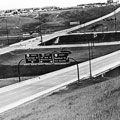|
Roads and Highways
 At the turn of the
20th century,
the horse was the main mode of transportation in
Alberta. In fact, in 1921 the equine population in
Alberta totaled 806,000 animals. At the turn of the
20th century,
the horse was the main mode of transportation in
Alberta. In fact, in 1921 the equine population in
Alberta totaled 806,000 animals.
The first cars that arrived in
Alberta were powered by steam. The first gasoline
powered engines were developed at the end of the
19th century, but they were not popularized
until the early 20th century when Henry Ford
began producing automobiles on the production line. This increased the
speed of production and reduced the cost of each
vehicle. With affordable cars available, many Albertans
were purchasing them.
By 1906, there were 41 vehicles in
the province and the government of Alberta passed the
Automobile Act. It set the speed limits at 10 miles per hour in towns and
20 miles per hour
outside city limits. The government set a budget of half
a million dollars for roads and bridges.
In
1936, the Alberta government developed a five-year plan
to place hard surface on one thousand miles of highway
because it was clear that the number of vehicles in
Alberta had increased significantly, reaching 100,000 by
1937.
The Second World War made necessary
the improvement of many of Alberta's roads. Roads and airfields were rapidly built or improved
to support the large number of facilities in Alberta for
the British Commonwealth Air Training Plan (BCATP). Alberta was
also host to the building of the Alaska Highway, which
was initiated by the United States because of the threat
of a Japanese invasion of Alaska. The highway was built
between Edmonton and Fairbanks, Alaska along a line of
existing airfields, traditional trails, and winter
roads.
In 1948, the Trans-Canada Highway Act
legislated the construction of a highway
that would stretch east and west across Canada. It was
opened in 1962, and the work was complete in 1965. The
Trans-Canada Highway is recognized as the world's
longest continuous highway in the world with a total
length of 7,511 kilometres.
Today, Alberta has one of the best
road and highway systems in Canada, providing the
transportation corridors needed for strong economic
growth.
|  Heritage Community Foundation Presents
Heritage Community Foundation Presents
 Heritage Community Foundation Presents
Heritage Community Foundation Presents